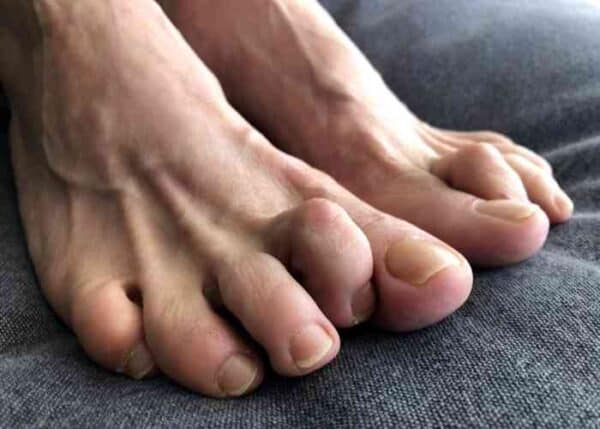Hammer Toe Correction Surgeons
Do you have a toe or toes that are bending involuntarily? Do you have difficulty walking, or pain while wearing shoes? If so, you may have a hammer toe. Hammer toe is a deformity of the foot in which one or more toes curl downward, resembling a hammer or a claw. Hammer toe correction surgeons, Doctor C. Thomas Haytmanek and Jonathon Backus have diagnosed and treated many patients in Vail, Colorado, and surrounding Eagle, Vail, and Gore Mountain Ranges who have hammer toe. Contact The Steadman Clinic’s Sports Foot and Ankle team today!

What is Hammer toe and how does it develop?
Hammer toe is a deformity of the foot in which one or more toes bend or curl downward, resembling a hammer or claw. It typically affects the second third and fourth toe, but can be found in any of the toes. Hammer toe can be caused by one of several factors: Genetics, injury, wearing tight shoes or high heels, or an imbalance of the foot intrinsic and extrinsic muscles over time.
Hammer toe may not cause pain or discomfort in the early stages, however as the condition progresses, it can become more painful and make it difficult to wear shoes or affect normal movement such as walking. Hamer toes are typically divided into two categories. A flexible hammer toe can be manually straightened back to a normal position. These are treated with stretching (correcting the toe to a normal position and holding for 30 seconds) and foot intrinsic exercises (such as picking up a towel with your toes). As the condition progresses the toe may become permanently bent (rigid). If a rigid hammer toe is causing wounds or pain for the patient, surgery may be recommended. Our doctors at Sports Foot and Ankle specialize in Hammer Toe Correction for patients from Vail, Colorado, and the surrounding Eagle, Vail Mountain Ranges that may benefit from hammer toe surgery.

What are the symptoms of hammer toe and how is it diagnosed?
Ultimately, hammer toe is the result of a muscle imbalance, muscles work in pairs to straighten and bend joints. When the toe is bent in one position for too long the muscles and joints tighten and cannot stretch out. In severe cases, they become fixed and this is termed a rigid hammer toe.
If the joint is still flexible, you may be able to straighten it out by forcing it into a straight position. However, without exerting effort to maintain a straight toe, the deformity will return. A flexible hammertoe can become rigid over time, so it is important to seek care for hammer toe before the condition progresses. It is considered a rigid hammer toe when the tendons of the toe contract, tighten, and force the joint out of alignment. Once the joint is severely affected, you cannot move the toe and it is permanently bent.
Additional symptoms may include:
- Pain while walking or wearing shoes
- Difficulty walking
- Swelling or redness
- Corns or callus on the top of the joints
- Difficulty walking
What is the treatment for hammer toe?
To determine whether hammer toe surgery may be the best solution for you, our specialists will perform a physical examination to determine if the toe joint is flexible or rigid and may obtain X-rays.
Non- Surgical treatment:
In the early stages, when your joints are still flexible, some simple measures can be taken to slow or reverse symptoms. Changing footwear can be very helpful. Since women’s footwear is often designed in such a way that it puts feet in uncomfortable or unnatural positions, women are more prone to hammer toe and footwear is often a major factor. Avoiding tight and narrow shoes can make a drastic difference. The best shoes to avoid a hammer toe correction will have a soft, roomy toe box.
Additionally, some specific exercises can help stretch and strengthen the muscles in the foot. The doctor can create a stretching protocol for you that addresses your specific needs and helps you avoid hammer toe surgery.
Surgical treatment:
If a problematic toe joint still has a range of flexibility, hammer toe correction can be done by lengthening the tendons that are causing the joint deformity. This type of procedure is reserved for flexible hammer toe deformities that are causing significant problems with shoe wear.
If non-surgical treatments do not relieve your symptoms or your toe joint is rigid, the doctor may recommend surgery. Hammer toe correction typically involves an incision over the prominent bone, lengthening the surrounding tendons and ligaments and shortening the bone. A removable wire or metallic implant can be used to hold the toe in a corrected position.
For ridged toe joints, our surgeon may remove the ridged joint by removing the end of the bone at the joint and will secure it in a straight position temporarily with pins. Depending on the severity of the hammer toe, this procedure involves removing a small part of the bone to extend the toe fully and a wire or permanent implant will be put in place while the bones fuse.
How long does hammer toe correction surgery take and what can I expect from the procedure?
Hammer toe correction is typically an outpatient procedure; however, the actual procedure will depend on the specific needs of the patient, and the type and extent of the deformity. Recovery time is typically 4-6 weeks before the patient can resume normal activities and 6 months for a full recovery. The doctors at Sports Foot and Ankle will direct patients movement and/or taping of the toes after surgery to ensure the best long-term outcome following hammer toe correction.